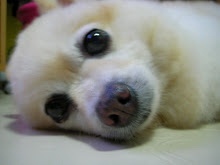Together with my partner, EF, we were the guides for the Noble Volutes. They were really a joy to be with, because they were such a fun and attentive group!
The hunters and seekers were fantastic that day, and brought us many interesting finds. Unfortunately I was so engrossed in guiding that I totally forgot to take many photos!
As it was too early in the morning, there were no NEA vans so we could take a nice leisure walk to the start-point, sharing our experiences with mother nature along the way. To ensure that we do not overfeed the mossies, we stopped at the wash-up point to apply insect repellent. The guides also took the chance to give the do's and dont's briefing to our group members.
(Photo courtesy of my partner)
One of the first animals of the day was the Haddon's Carpet Anemone (Stichodactyla haddoni).
Spreading out nicely like a carpet, the carpet anemone has stinging cells in their tentacles, for purpose of self defense and preying. These stingers can inject a toxin that affects small animals. The anemone does not have an anus and has to spit out any indigestible food before swallowing the next one (quite inefficient, isnt it?) !
An anemone shrimp was also found together with this anemone. Anemone shrimps (Periclimenes brevicarpalis) usually look for food among the tentacles of the anemone, and protect themselves from the stinging cells by coating their bodies with mucus.
The visitors were awed by the cute juvenile cushion star (Culcita novaeguineae). Like its other relatives, the cushion star has tube feet and is symmetrical along 5 axis along its body, and lies on their mouth. Unlike human beings who circulates blood through our body, water is circulated through the seastar's body. This is referred to as the hydraulic water vascular system. Thus, the visitors are reminded not to lift them from the water for too long a time.
In the same family as seastars, the Synaptid sea cucumber (Family Synaptidae) is the longest sea cucumber, that can grown up to 3m long! Due to its thin body wall, the Synaptid sea cucumber is therefore very delicate. It has no tube feet unlike other sea cucumbers. Instead, they have hooked spicules that acts somewhat like the velcro and feeds by lashing its tentacles in the water for detritus.
I particular love the expressions and reactions of the visitors when I introduced the Spider conch (Lambis lambis). Named after its long spider-like spines, the spider conch is very well camouflaged by that thick layer of algae. In contrast, the lovely smooth underside never fails to bowl the visitors over, esp in comparison with the 'ugly' upperside.
The spider conch has 2 large pretty eyes at the end of the tentacles and a thick siphon. Like other conch snails, the animal is a champion pole-vaulter, with the help of a strong operculum.
see how attentive they are to the Spider conch's pretty underside! (photo courtesy of my partner)
As we were walking to the next station, one of the visitors spotted a Flatworm (Pseudoceros sp.). Flatworms are called flatworms for obvious reasons - they are really flat! This helps them weave easily into any space. They do not have a respiratory nor blood circulatory system, thus oxygen diffuses quickly across its skin. Most flatworms are carnivorous, and preys on tiny animals by injecting digestive juices into the prey. An interesting fact about this animal is its possession of both male and female reproductive organs. Some species of this hermaphrodite thus tries to impregnate each other (because its never easy to be a mum!) through 'penis-fencing'.
Before we could proceed further, dark clouds loomed the sky, and for safety reasons, we had to scamper back to the shelter. All of us were crossing our fingers for the rain to stop.
Thankfully, the rain stopped after 15mins or so. Although we could be running behind schedule, we continued the intertidal walk as all the visitors were eager to see more.
Once again, we tracked through the secondary forest, and crossed the largest seagrass meadow in Singapore.
Certainly very glad to have continued on the journey, otherwise we would have missed the icons of Semakau - the Knobbly sea star (Protoreaster nodosus) ! Although the one we saw was probably only 15cm wide, the knobbly can grow up to 30cm wide! Named after the knobs on their bodies, they also have tube feet under their arms and prefers to eat clams/ snails. I've seen one of them in an aquarium shop in Plaza Sing ='( - such collection and the lost of habitat have threatened the survival of these pretty sea stars, so remember not to support the trade!
We also saw one of what is considered delicacy to us Chinese - the sandfish sea cucumber (Holothuria scabra). While it is edible, it needs to be processed first as it is mildly poisonous. They belong to the same family as sea stars but instead of lying on their mouths, the sea cucumber lies on its side, has a mouth at one end and anus on the other. They also have a hydraulic water vascular system and cannot be out of water for a long period of time as they might disintegrate. When stressed, the sea cucumber ejects water, some species may eject a stick latex or even internal organs! While they can regenerate themselves, I can imagine how painful the process will be!
The group photo with the Knobbly sea star marks the end of the trip (photo to be uploaded soon!). The guides had a fantastic time, and silently hoped that the visitors had the same sentiments too! =)













No comments:
Post a Comment